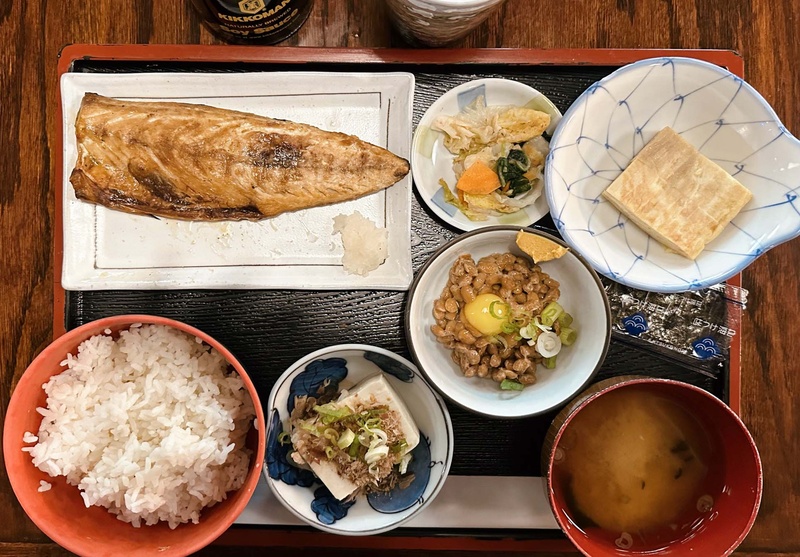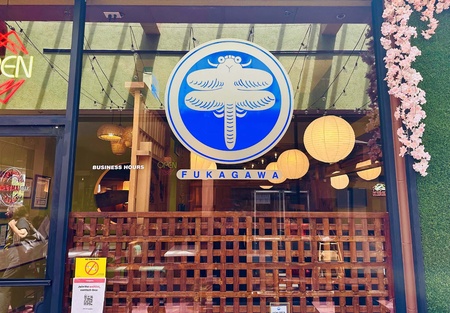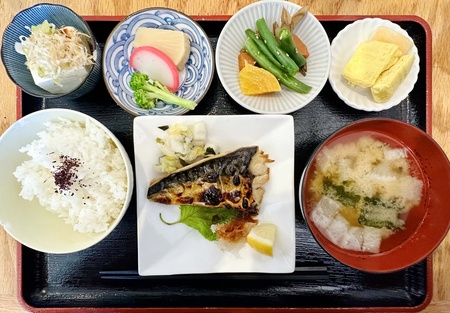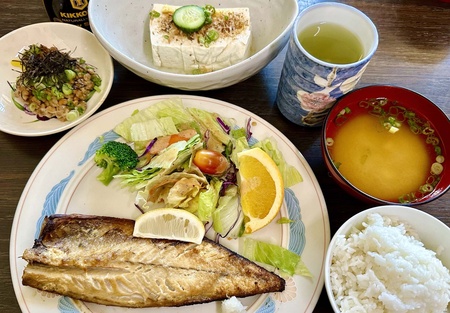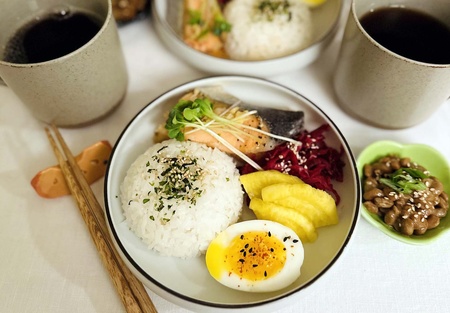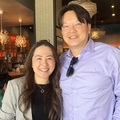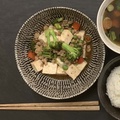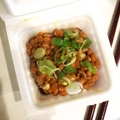I’ve been to Japan three times. Over the course of those visits I had so many delicious meals; rich, deep curries; ramen noodles immersed in intense, flavorful broth; sushi that was so fresh my cousin slapped it in the cup of her hand because she said it was still moving (yes, I actually did see it move and yes, it freaked me out.)
But the meals that made the biggest impression are the breakfasts. I’d never had a traditional Japanese breakfast before I visited Japan for the first time in my teens, and I wasn’t sure what to expect. Breakfast has always been my favorite meal of the day and I was skeptical that a spread of fish, rice and miso soup could compete with my beloved artery-clogging plate of runny, over-easy eggs, thick-sliced bacon and hearty toast slathered in butter.
After that first breakfast I was hooked. The idea of eating traditional Japanese foods for breakfast had never occurred to this American girl, but it totally made sense: starting the day with a light, nutrient dense, protein-packed meal was not only healthy, but aesthetically much more appealing than any diner-style breakfast I’d ever had.
“Central to Japanese life values, the traditional Japanese breakfast also illustrates the concept of balance,” wrote Namiko Chen, of the popular Japanese cooking site, JustOneCookbook. “You can see a thoughtful composition of color, taste, aroma, and texture in the meal itself.”
What exactly is Japanese breakfast? It consists of several small portions of traditional foods: a main dish of grilled fish (usually mackerel), miso soup, rice, tsukemono, tofu, a vegetable dish, an egg dish like tamagoyaki, and sometimes, if you’re lucky, natto. (Sorry, natto haters – I say these fermented beans are an essential component of a Japanese breakfast.)
It’s important to note that Japanese breakfasts are served with green tea, not coffee. I’m still not used to this. So, if you’re like me and can’t fathom the idea of a coffee-less breakfast, you might want to have your fix before you leave home. Also, warn your breakfast companions that you might repeatedly mention your desperation for coffeethroughout breakfast (true story.)
Unfortunately, a traditional Japanese breakfast is surprisingly hard to find outside of Japan. In Southern California, where we have the largest concentration of Japanese Americans in the state, I found only a few places that serve a traditional spread. Here’s what I found on my delicious journey to find the somewhat elusive Japanese breakfast in and around L.A.
* * * * *
FUKAGAWA
If you mention Japanese breakfast, the first name that comes up is Fukagawa in Gardena. Tucked into the corner of the bustling Pacific Square shopping center, they’ve been serving up homestyle, traditional Japanese food for over 30 years. They not only serve Japanese breakfast, but have six different combinations that you can choose from, so if fish isn’t your thing, you can sub in a steak. I chose the combo that had grilled mackerel, rice, tamagoyaki, miso soup, tsukemono and natto, which was served with a raw egg, in case you were wondering how legit this place is. The portions are generous, and I like that afterwards you can walk next door to Marukai to pick up all the ingredients to make your own Japanese breakfast at home.
AZAY
Chef Akira Hirose’s Azay in Little Tokyo serves up a gorgeously presented Japanese breakfast that consists of saba mackerel, dashimaki tamagoyaki (a signature recipe), tsukemono, vegetables, miso soup and rice. There’s no natto served with this version, but I think I can forgive them because it was so delicious and thoughtfully prepared. Although not part of a traditional Japanese breakfast, we couldn’t help ourselves and ordered their pear tart tartin for dessert and we were glad we did. I guess it sort of made up for the natto.
OTOMISAN
My third – and favorite – stop was at Otomisan. This quaint, homey restaurant has been in business for 66 years and is the last Japanese restaurant in Boyle Heights as well as the oldest Japanese restaurant in L.A. They don’t have a Japanese breakfast on the menu, but they do have all of the components. I figured if Ikea can sell me a bunch of wood panels and I can make myself a desk out of them, I could surely put together my own Japanese breakfast. And I was right – I ordered their saba shio entree that comes with rice, miso soup, tofu and salad and added on a side of natto and it was perfect. I was so excited at my DIY breakfast I forgot to ask about an egg dish, but I’ll bet they could have given me an over-easy on the side.
MAKE IT YOURSELF
Lastly, you can always make a Japanese breakfast at home. Here’s one I put together with some leftover salmon, rice, a jammy egg, tsukemono, miso soup and natto. It’s simple, and making a meal like this takes me back to my teen self, and that first Japanese breakfast I had in Japan. And while my living room lacks the charm and authenticity of a Japanese restaurant, here coffee is always on the menu.
|
Fukagawa Azay Otomisan |
© 2023 Marsha Takeda-Morrison


